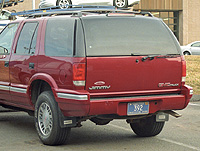
As is the case for most New England states, having a low-numbered license plate is seen as a sign of “prestige”. Perhaps this is related to the tradition of issuing the same license plate number to a person basically for life (if they so choose to keep it). People become more attached to their license plate number, and it becomes part of their identity. Having a low number also can be indicative of “knowing people in high places”, which is often a prerequisite to obtaining one of these plates. Generally, the lower the number the more connected the person is. Either that, or the number has been in the family for generations.
Low number plates were generally issued only through the office of the Commissioner of Motor Vehicles, though that has been relaxed at times in recent years.
Low number plates were traditionally considered those with numbers below 5000. In 1991, the law was changed to raise the upper limit of low number plates to 10000 – essentially making any 4-number plate a low number.
 1919
1919
While probably not technically a “low-number” plate, but rather just one in the family for a while, I’m still including it here since it fits the theme. Up until the plate size in Connecticut was standardized in 1932, the length of the plate varied with the number of digits. This one is pretty short. This plate was used on a 1915 Pierce-Arrow in New Haven.
 1923
1923
This plate was issued to Louis R. Cheney, likely for use on his 1919 Buick Coupe.
He was a somewhat prominent local figure, involved as a director or trustee of a litany of venerable Hartford-area institutions and companies.
At one time he commanded the 1st Company Governor’s foot guard, was mayor of Hartford from 1912 to 1914 and was a state Senator from 1915 to 1917.
He was also issued plate number 454.
 1936
1936
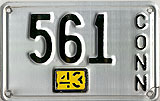 1943
1943
 ca. 1948 revalidated to 1956
ca. 1948 revalidated to 1956
(Yellow Scotchlite background)
Sticking with the “under 5000” theme.
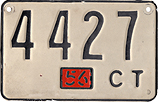 ca. 1951 revalidated to 1956
ca. 1951 revalidated to 1956
(White Scotchlite background, skinny dies)
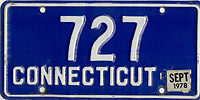 1957 Base Revalidated to 1978
1957 Base Revalidated to 1978
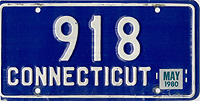 Revalidated to 1980
Revalidated to 1980
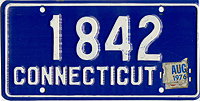 Revalidated to 1976
Revalidated to 1976
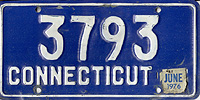 Revalidated to 1976
Revalidated to 1976
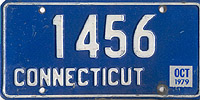 1969 Base Revalidated to 1979
1969 Base Revalidated to 1979
 1976
1976
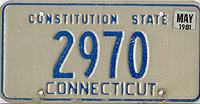 1974 Base Revalidated to 1981
1974 Base Revalidated to 1981
 This is an oddity. It is mostly in the style of the 1969 base, but is reflectorized (which wasn’t introduced until the 1976 base), the “Connecticut” legend is the wide version from the 1957 base, and the number position is similar to 1980s plates.
This is an oddity. It is mostly in the style of the 1969 base, but is reflectorized (which wasn’t introduced until the 1976 base), the “Connecticut” legend is the wide version from the 1957 base, and the number position is similar to 1980s plates.
 ca. 1977 revalidated to 1990
ca. 1977 revalidated to 1990
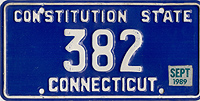 ca. 1977 revalidated to 1989
ca. 1977 revalidated to 1989
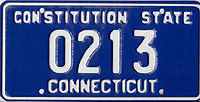 1980s
1980s
While technically falling into the low-number category, these lead-zero plates have always seemed to be pseudo-low-numbers – after all, there is a real “213” out there.
 1980s
1980s
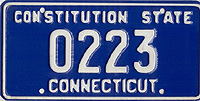 1980s
1980s
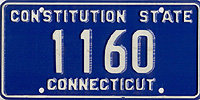 1980s
1980s
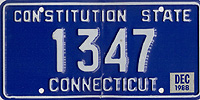 1988
1988
 1978
1978
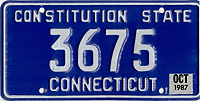 1987
1987
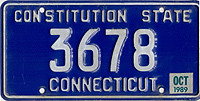 1989
1989
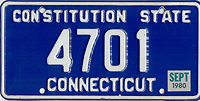 1980
1980
 1994
1994
 1991
1991
 1993
1993
 1991
1991
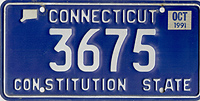 1991
1991
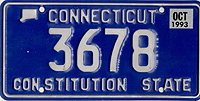 1993
1993
 1990s
1990s
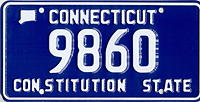 1990s
1990s
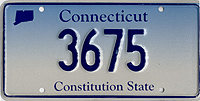 2000s
2000s
 2000s
2000s
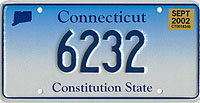 2002
2002
 2000s
2000s